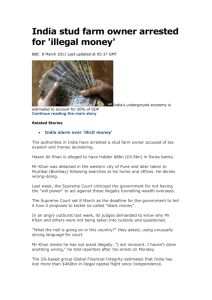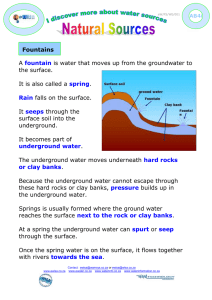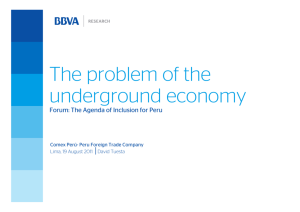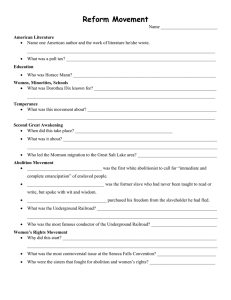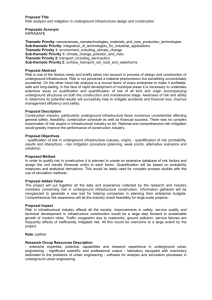How Much Money Is Laundered?
advertisement
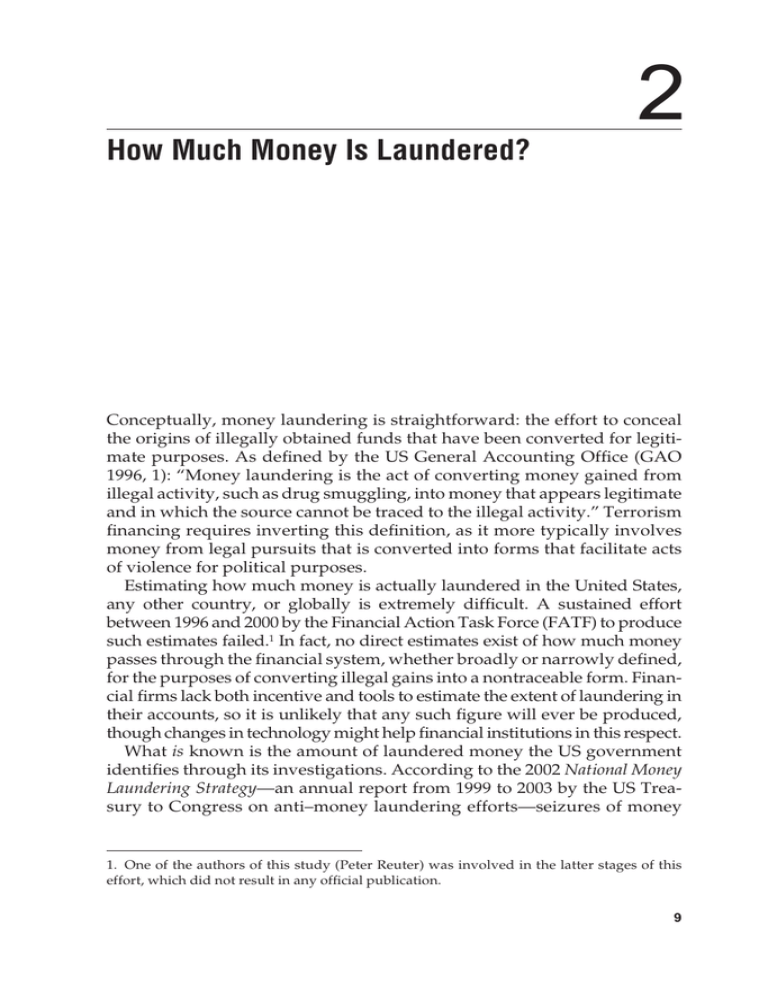
2 How Much Money Is Laundered? Conceptually, money laundering is straightforward: the effort to conceal the origins of illegally obtained funds that have been converted for legitimate purposes. As defined by the US General Accounting Office (GAO 1996, 1): “Money laundering is the act of converting money gained from illegal activity, such as drug smuggling, into money that appears legitimate and in which the source cannot be traced to the illegal activity.” Terrorism financing requires inverting this definition, as it more typically involves money from legal pursuits that is converted into forms that facilitate acts of violence for political purposes. Estimating how much money is actually laundered in the United States, any other country, or globally is extremely difficult. A sustained effort between 1996 and 2000 by the Financial Action Task Force (FATF) to produce such estimates failed.1 In fact, no direct estimates exist of how much money passes through the financial system, whether broadly or narrowly defined, for the purposes of converting illegal gains into a nontraceable form. Financial firms lack both incentive and tools to estimate the extent of laundering in their accounts, so it is unlikely that any such figure will ever be produced, though changes in technology might help financial institutions in this respect. What is known is the amount of laundered money the US government identifies through its investigations. According to the 2002 National Money Laundering Strategy—an annual report from 1999 to 2003 by the US Treasury to Congress on anti–money laundering efforts—seizures of money 1. One of the authors of this study (Peter Reuter) was involved in the latter stages of this effort, which did not result in any official publication. 9 laundering–related assets in fiscal 2001 amounted to $386 million, while the corresponding figure for forfeited assets was $241 million. Considering the billions of laundered dollars believed to be out there, a few hundred million dollars annually is a negligible share of the true total. A number of estimates have been published of the potential demand for money laundering, i.e., the quantity of funds generated through either crime or legal activities that are concealed from authorities in order to evade taxes as well as what Vito Tanzi (1980) in his classic article calls “various governmental restrictions on the activities of economic agents.” Estimating this demand can be done through either a macroeconomic or microeconomic approach. The various macroeconomic methods might be expected to produce a rough upper bound of how much money is laundered, simply because it is impossible to make fine distinctions in these studies. The microeconomic method, which involves summing up the income generated by major crime categories, provides a loose lower bound on the demand for money-laundering services. A review of the two methods comes to a simple conclusion: neither yields estimates of the volume of laundered money that can be considered as anything more than an indicative order of magnitude. Such figures are useful to confirm that the phenomenon of money laundering is of sufficient scale to warrant public policy attention, but their quality is not good enough to provide guidance for policy. Moreover, the macroeconomic estimates are methodologically flawed, while the available microeconomic estimates lack credible empirical foundations. These negative conclusions regarding the accuracy of these estimates are based on a fairly detailed and technical review. Confronting this reality is critical because ignorance about the volume of money laundering is an important conditioning reality for policymakers as well as for any assessment of the AML regime’s effectiveness. Without a measure of how much money is laundered, the most obvious and direct outcome measure for an anti–money laundering regime—reductions in the targeted activity—is not available. More indirect measures must be developed. It seems unlikely to us that direct measurement of the total volume can be improved in the foreseeable future. Even measures of predicate crimes, the principal targets of the control regime, are crude. Such a negative assessment, however, does not imply an endorsement of policymaking-by-anecdote in this or any other area. To the contrary, a recurring theme in this study is that better use could and should be made of available data on particular aspects of money laundering, and greater thought should be given to collecting and assembling relevant statistics that aid policymakers. Even these efforts, however, are unlikely to produce a global aggregate of the amount of money laundered that can be used to monitor progress in control efforts. As discussed in chapters 5 and 8, more disaggregated measures are needed to assess the seriousness of the money-laundering problem. 10 CHASING DIRTY MONEY Macroeconomic Estimates The macroeconomic approach to measuring the extent of money laundering is based on a broad definition that assumes that any revenue on which no tax is paid—be it from a legal or illegal activity—will need to be laundered in some way.2 In this view, the demand for money laundering is related to the monetary component of the so-called underground economy. The study of what has been called the underground, shadow, or hidden economy first emerged in the late 1970s (Gutmann 1977, Feige 1979). It has since evolved into a considerable body of literature that proposes a host of different techniques for estimating the size of the phenomenon. More recently, one particular estimation method, the currency-demand approach, has been applied frequently enough to allow for comparison of many different countries over one or two decades. The first step of this method, developed by Tanzi (1980), estimates a currency-demand function for the concerned country. The dependent variable is the ratio of currency holdings to a broad measure of the money supply such as M2, and on the right-hand side of the equation are series for the following: tax rates (higher taxes are expected to induce use of currency to evade them), share of wages and salaries in personal income (these types of income are more often than others paid in cash), interest rates (as the opportunity cost of holding currency), and real per capita income (as a proxy for financial infrastructure, the degree of urbanization and mobility; higher income decreases the use of cash). The second step, which is based on the estimated equation and actual values of M2, can determine for each year the level that currency holdings would have been with taxes at either the lowest level of the sample period or at zero. The difference between this estimated figure and the actual observed cash holdings is then attributed either to the entire underground economy when a zero tax rate is used, or to its increase since the year with taxes at their lowest level. Assuming that income velocity of currency circulation is the same in the underground and legal economies, the third 2. Theoretically, it would seem reasonable to assume that no taxes are paid on income from illegal activities, but there are rare exceptions, such as when an offender chooses to launder criminal earnings through a legitimate business and pay some taxes. HOW MUCH MONEY IS LAUNDERED? 11 Table 2.1 Activities Illegal activities Legal activities Taxonomy of underground economy activities Monetary transactions Nonmonetary transactions Trade in stolen goods, drug manufacturing and dealing, prostitution, gambling, smuggling, fraud Barter (drugs, stolen goods, smuggling, etc.); production of drugs for own use; theft for own use Tax evasion Tax avoidance Tax evasion Tax avoidance Unreported income from self-employment; wages, salaries, and assets from unreported work related to legal goods and services Employee discounts, fringe benefits Barter of legal services and goods All do-it-yourself work and neighbor help Sources: Mirus and Smith (1997) and Schneider and Enste (2000). step computes the corresponding estimates of the total volume of the underground economy or its increase.3 What is the currency-demand approach measuring, and how well does it match the broad working definition of money laundering used in this study? Clearly, the estimates are measures of a cash-based underground economy dependent on particular levels of taxes and extent of tax evasion, which is in line with the definition. Tanzi (1980) himself defines the underground economy as the “gross national product that, because of unreporting and/or underreporting, is not measured by official statistics.” The impact of tax evasion on national accounts is unclear, and depends on both the particular taxes evaded (e.g., personal income taxes may be more easily evaded than property taxes) and on the methods used for estimating each of the components of the national accounts. As a result, Tanzi’s definition is probably too general to match the specifics of his own method, but precise enough to provide a reasonable upperbound estimate of total money laundered. Friedrich Schneider and Dominik Enste (2000) also apply the currencydemand approach. They present a “reasonable consensus definition” of the underground economy based on an earlier schematization by Rolf Mirus and Roger Smith (1997). Their taxonomy (table 2.1) better describes what the currency-demand approach estimates, and also illustrates conceptually a broad measure of money laundered. Schneider and Enste distinguish between monetary and nonmonetary transactions. The latter, by definition, cannot be measured by the currency-demand approach and cannot in the first instance give rise to any money to be laundered. Schneider and Enste also 3. A more restricted variation on this method is the currency-ratio approach described in Feige (1997). It uses the ratio of currency to demand deposits and makes the restricting assumption that this ratio is affected only by changes in the underground economy. 12 CHASING DIRTY MONEY distinguish between legal and illegal activities. With the reasonable assumption that no taxes are paid on illegal activities, it is the sum of the legal and illegal categories of monetary transactions in the underground economy that give rise to money laundering in its broadest definition.4 Schneider and Enste provide roughly comparable estimates of the underground economy for many countries based on the currency-demand approach. Using their 2000 study as well as a later paper by Schneider (2002), table 2.2 shows figures for 21 member countries of the Organization for Economic Cooperation and Development (OECD) for selected years since 1989. The figures illustrate the extraordinary magnitude of money-laundering estimates using this approach. On the basis of these estimates, the combined underground economies of these 21 countries in 1997 totaled more than $3 trillion annually, and for single nations the underground economy represented an average of 16 to 17 percent of GDP. For all the years listed, the amounts estimated are more than 7 percent of global GDP, and since 1994 the figure exceeds 10 percent for most years.5 This is substantially above the 2 to 5 percent of global GDP cited in 1998 by Michel Camdessus, then managing director of the International Monetary Fund, as a “consensus range” for the scale of money-laundering transactions. Even this lower guesstimate was described by Camdessus (1998) as “beyond imagination.” Differences across countries may be partly explained by differences in taxpayer cultures and by tax rates themselves. For example, southern European nations (Greece, Italy, Portugal, Spain) and Belgium, all of which are thought of as having a tradition of low tax compliance, have the highest proportion of GDP estimated as coming from the underground economy, with figures above 20 percent for all years since 1994. The heavily taxed Scandinavian countries follow them closely. The United States, Austria, and Switzerland have much lower rates, less than 10 percent. Not surprisingly, considering the size of US GDP, the United States leads the field in absolute terms, with $650 billion to $800 billion in 1995 dollars, followed by Japan and Germany. Italy and Spain are the only countries with both underground economies accounting for more than 20 percent of GDP and contributions to the worldwide underground economy in absolute numbers of more than $100 billion. The absolute and percentage estimates are shocking if taken as measures of money laundering. However, they are frail even in their own terms as measures of what evades government taxation and other restrictions, and even more frail as the basis for estimating the volume of money laundered. 4. Transaction measures are broader than value-added measures, however, in that the former encompass the gross expenditures at all stages in the production of output, while the latter are net of inputs. Thus, gross transaction measures of the underground economy tend to overstate its size relative to value-added measures of the total economy. 5. Based on world GDP in constant 1995 dollars. See World Bank (2003b). HOW MUCH MONEY IS LAUNDERED? 13 14 1,019.2 14.1 12.7 Total Average 14.3 16.0 13.0 7.1 20.8 13.5 15.0 16.1 13.8 12.5 24.9 14.2 24.0 9.5 12.7 9.0 16.7 17.2 17.3 17.0 6.9 11.2 8.2 2,389.6 1,215.3 41.5 15.6 54.3 70.4 24.8 20.2 205.3 291.8 28.4 7.7 250.6 483.5 48.5 4.6 21.1 17.3 96.7 39.2 21.1 114.9 532.0 16.0 17.9 13.0 9.9 21.4 14.6 17.6 18.2 14.3 13.1 26.0 15.3 25.8 10.6 13.6 11.3 17.9 22.1 22.3 18.3 8.7 12.4 9.4 2,778.1 1,366.6 46.8 22.9 57.6 82.3 30.9 22.7 218.4 316.6 29.9 9.3 275.0 552.3 55.2 6.5 25.3 23.1 126.8 42.4 26.6 135.9 671.7 16.7 18.8 13.9 8.9 22.4 14.8 18.1 18.9 14.7 15.0 29.0 16.1 27.3 11.1 13.5 11.9 19.4 23.1 23.1 19.8 8.0 13.0 8.8 3,081.4 1,552.4 56.7 21.6 64.7 90.9 34.4 27.0 235.2 376.8 36.1 12.7 308.9 618.7 59.9 7.5 31.2 26.7 143.7 49.1 25.1 155.5 699.0 16.7 18.6 14.3 9.6 22.2 16.0 18.0 18.1 15.2 15.5 28.7 15.9 27.1 11.2 13.1 12.8 19.1 22.7 22.7 19.2 8.3 12.7 8.7 3,255.5 1,643.8 64.1 24.8 67.4 106.1 35.9 28.4 258.8 403.5 38.1 15.0 317.3 622.1 62.4 8.4 31.8 28.1 153.2 51.3 27.0 159.5 752.1 16.7 18.6 14.1 10.5 22.0 15.8 17.9 18.0 15.0 16.0 28.5 15.7 27.0 11.1 13.0 12.6 19.0 22.5 22.5 19.1 9.3 12.5 8.7 3,402.7 1,730.8 66.0 28.2 70.2 111.1 37.1 30.1 268.7 431.2 41.1 17.6 331.1 628.6 64.8 8.6 32.8 29.4 162.4 53.5 31.6 165.4 793.1 Sources: Underground economy as percent of GDP: Schneider and Enste (2000) and Schneider (2002). Absolute numbers calculated from official GDP data in World Bank (2003b). Note: Data for the underground economy as a percent of GDP are the average of the cited and the following year for all countries for 1991; all countries except Austria, Germany, and Switzerland for 1989, 1999, and 2001; for Finland, Japan, and Portugal for 1994; and for Finland, Greece, Japan, New Zealand, and Portugal for 1997. All exceptions referenced in this note are in italics in the table. Absolute numbers are in constant 1995 dollars. a. Estimates for 2001 are preliminary. 2,004.9 32.2 16.8 48.1 67.9 17.5 17.9 129.2 250.7 25.0 5.4 230.3 412.4 42.7 4.8 17.8 15.0 84.8 36.5 21.4 99.3 429.4 10.1 8.3 19.3 12.8 10.8 13.4 9.0 11.4 22.6 11.0 22.8 8.8 11.9 9.2 14.8 15.9 16.1 15.8 7.2 9.6 6.7 1989 1991 1994 1997 1999 2001a Percent Billions Percent Billions Percent Billions Percent Billions Percent Billions Percent Billions of GDP of dollars of GDP of dollars of GDP of dollars of GDP of dollars of GDP of dollars of GDP of dollars Estimates of the underground economies of 21 OECD countries, 1989–2001 Australia Austria Belgium Canada Denmark Finland France Germany Greece Ireland Italy Japan Netherlands New Zealand Norway Portugal Spain Sweden Switzerland United Kingdom United States European Union members Country Table 2.2 By definition, the entire right-hand, nonmonetary side of table 2.1 is not included in these estimates of money laundering, as these items were excluded by the estimation method used by Schneider and Enste (2000) and do not fit conceptually. Moreover, the currency-demand approach has been extensively and convincingly critiqued (Tanzi 1999). First, its strong focus on taxes to explain the size of the underground economy ignores the criminal trades, which are not a function of tax rates but of other factors (such as the demand for illegal drugs); it measures only the lower left-hand side of table 2.1. For example, removing legal restrictions on casino gaming in the 1990s in many American states may have reduced the size of the illegal gambling sector. Second, the currency-demand approach assumes that the underground economy consists of only cash transactions. Studies in Norway have suggested that cash may account for only about 80 percent of such activities (Isachsen and Strom 1980, 1985). Moreover, some money laundering, such as that associated with financial fraud, is done primarily, if not exclusively, in noncash monetary transactions such as electronic transfers. Third, the currency-demand approach assumes that income velocity is the same in the hidden and the official sectors. As the two are likely to have very different structures, that assumption is almost certainly false. Fourth, the estimates presented in table 2.2 are based on the strong assumption of no underground economy in the year with lowest taxation. When designing the currency-demand approach, Tanzi explained that predicting a currency-to-M2 ratio based on the lowest level of taxation over the sample period would indicate the increase in the underground economy since the year of that lowest tax level. Theoretically, Tanzi maintained, one would need to put taxes at zero to estimate the entire underground economy. Schneider and Enste are less explicit in laying out the framework for their econometric work, but they do mention that a weak point of the approach is the assumption of no underground economy in the base year. The fact that the already enormous estimates would be further inflated if based on a currency-to-M2 ratio predicted with zero taxes raises serious doubts about the accuracy of the estimates. Finally, substantial amounts of currency are held outside certain countries. For countries with currencies used internationally (the United States, Germany [prior to 1999], the euro countries, the United Kingdom, Japan, and Switzerland to some degree), this factor might change the results substantially, because currency held abroad should be excluded to obtain a net volume of the domestic underground economy. If currency abroad is not part of the domestic underground economy, it might well be in the foreign underground economy. This implies that this method is not reliable for purposes of measuring the volume of money laundering in the countries issuing international currencies, but in principle may be appropriate for constructing a global aggregate if one could reallocate the currency appropriately. HOW MUCH MONEY IS LAUNDERED? 15 Unfortunately, there are no promising ways around these problems. For example, it is difficult to find a proxy for illegal activities to include in the equation. Nor is there any promising approach for estimating income velocity in the hidden sector. The reliance on currency as the basis for measuring money laundering resulting from illegal drugs imparts the right bias by excluding the nonmonetary sector and taking into account the huge amounts of cash in the drug trade. That advantage will be lost with other macroeconomic approaches. There are contending macroeconomic approaches. One alternative method is based on the discrepancies between different components of national income accounts. For example, nonreporting or underreporting may affect income statistics differently than other national accounts categories such as consumption. Second, one can compare official data on the labor force with data based on household surveys, and take the difference as an indicator of underground economic activity. The third alternative option is the so-called physical input approach. Based on total real physical inputs (most typically electricity), it estimates total GDP, subtracts official GDP from it, and attributes the difference to underground activity. Lastly, the underground economy has been estimated with an econometric method that allows for estimating an unobserved variable “between” certain observable causes and effects.6 When used individually, all of the alternative approaches have obvious and very substantial shortcomings. For example, simple comparisons of different national accounts categories may not be meaningful because this procedure conflates measurement error with unrecorded activity. Labor surveys may be biased, physical inputs measure only “underground industrial” activity, and the associated econometric modeling requires a set of strong assumptions. The results themselves also reduce the credibility of the various economic approaches. Derek Blades and David Roberts (2002) make telling comments in reviewing various estimates. Their main critique is that nonobserved activities are highly concentrated in certain sectors of the economy, such as retail trade, taxis, trucking, and restaurants, while other sectors such as power generation, heavy industry, or air transport are intrinsically less vulnerable. Taking this into account, the high estimates of the size of underground economies would imply that much larger shares of the susceptible sectors are underground, which hardly seems credible. Considering, then, that the different shortcomings tend to bias the results, and sometimes in different directions, it is best to take the different figures with several grains of salt. At best, the various estimates suggest that there is substantial potential demand for money-laundering services, but there is little basis for concluding whether it amounts to hundreds of billions or trillions of dollars. 6. See Dixon (1999) for a brief review of various methods. 16 CHASING DIRTY MONEY Before moving to the discussion of microeconomic estimates of the amount of money laundering, it is important to recognize the substantial work that has been done on estimating underground economic activities in the context of the compilation of national economic accounts. Most countries today use the national accounting standards and definitions set out in the System of National Accounts (1993), and referred to as SNA93. A compatible but somewhat more specific set of rules is in force for countries in the European Union (EU), namely the European System of Accounts (Eurostat 1995), known as ESA95. To determine what needs to be included in complete national accounts, both systems use the notion of a “production boundary.” Everything that lies within the boundary is considered to have been produced, with some value added to it, and is to be included in the accounts, while everything beyond the boundary does not count as production or value added and is to be excluded. Presented in a very simplified way, according to SNA93 and ESA95, all goods and services produced with inputs of capital, labor, or any materials lie within the production boundary, with the sole exception of housing services provided by owneroccupiers. Goods that are not produced with such inputs, such as natural resources, are considered outside the boundary.7 The point is that for both SNA93 and ESA95 the concept of a production boundary is independent of whether an activity is illegal or performed in violation of certain regulations. Thus, many national statistical agencies have made considerable efforts to estimate nonobserved economic activity in order to include it in their GDP estimates. In particular, they have attempted to define in detailed fashion the different sectors of the underground economy, and to develop particular methods to measure each sector. Consequently, the findings are much more reliable than estimates based on general macroeconomic approaches such as those discussed above. Were they easily available and comparable, the national estimates could be useful for developing an overall measure of money laundering. However, although there has been considerable study and assessment by national and international agencies of all the particular methods of examining underground economies,8 practices at national levels vary widely. The most inclusive effort to collect and compare national practices and estimation results to date is a study by the UN Economic Commission for Europe (UNECE 2002). The study includes detailed reports by 29 countries about their methods of estimating underground activity. Eight are developed market economies and OECD members that are part of the principal focus 7. See Blades and Roberts (2002) for a simple representation of the production boundary. A more detailed account can be found in Jackson (2000, 120–34). 8. The most complete overview is probably the Handbook for Measurement of the Non-Observed Economy published by the OECD (2002) in cooperation with the International Monetary Fund, International Labor Organization, and the Statistical Committee of the Commonwealth of Independent States. HOW MUCH MONEY IS LAUNDERED? 17 of attention in this study: Belgium, Canada, Finland, Germany, Ireland, Italy, the United Kingdom, and the United States. Unfortunately, most of these countries, while adjusting for a host of different nonobserved activities, usually estimate these types of economic activities in a way that does not allow identification of a total figure for the underground economy (for example, as a percentage of GDP). The first exception is Italy, where the estimate of the underground economy as a proportion of total estimated GDP was 15 percent for 1998, i.e., a little more than half of what currency-demand-based macroeconomic estimates suggested for 1997 and 1999. The second exception is the United States, but in this case the efforts are limited to a survey of the literature discussed below in the section on microestimates. Moreover, US figures primarily cover the period around 1980 and are thus outdated for purposes of this study. Apart from these two countries, only Belgium and Canada provided estimates for the UNECE study of the correction in national accounts for nonobserved activities. In Belgium, these activities were reported to account for 3 to 4 percent of total estimated GDP in 1997, and in Canada less than 2.7 percent in 1992. The figures for these two countries (less so for Italy) are substantially below the estimates in table 2.2, demonstrating yet again the weakness of the currency-demand approach. Studies on underground economies related to national accounts also have their weaknesses when used to measure the scale of money laundering, specifically with regard to certain important types of illegal activities. First, some activities like theft or extortion do not fall within the production boundary. Second, even for the countries that do report on illegal activities, the UNECE (2002) study reports that the estimates “can only be regarded as indicative” due to “difficulties in measurement.” Third, notwithstanding such exceptions as the United Kingdom and the United States, most OECD members do not list any estimates for illegal activities at all, which again limits comparability.9 Two main lessons emerge from our review of attempts to estimate the amount of money laundering in the context of national accounts. On the one hand, insofar as data are available, they only reinforce the previous skepticism about the results from currency-demand estimation methods. On the other, the data show that there are sophisticated methods available that can be refined and may contribute to more meaningful estimates in the future of the size of the underground economy and volume of money laundering. 9. One reason for the limited coverage in OECD countries may be the confusion in EU norms. While the ESA95 (enacted in a Council Regulation in 1996) requires inclusion of illegal activities, a Commission Decision of 1994 excludes them from what is required of states to ensure complete national accounts (Art. 1 Commission Decision 94/168/EC, Euratom). Interestingly, Calzaroni (2001) notes that the Italian approach to estimating underground activity explicitly states that illegal activities are not included in line with EU requirements. 18 CHASING DIRTY MONEY Microeconomic Estimates The microeconomic approach to estimating the demand for money laundering is in a sense a complement to the macroeconomic approaches, which pay limited attention to estimating total earnings from criminal activities, aside from tax evasion. The microeconomic approach focuses on different types of crimes and on estimating the incomes from each. These estimates normally do not include the informal economy or activities that, though legal, are not reported in order to evade taxes. However, in principle it would be possible to graft those estimates onto such measures. The problems associated with the microeconomic approach basically involve the paucity and unreliability of the data. In other words, what little data are available are not worth much. There have been two systematic efforts to provide estimates of incomes generatedbyabroadrangeofcriminalactivitiesintheUnitedStates.CarlSimon and Ann Witte (1982) cobbled together figures for the late 1970s. Indicative of the uncertainty of their results, which they acknowledge, is the basis for their estimate for income from prostitution. They started with estimates of the number of acts of prostitution and the number that a full-time prostitute would commit in the course of a year. This calculation resulted in an estimate of full-time-equivalent prostitutes of 80,000 to 500,000. Add in considerable uncertainty about the annual earnings of a prostitute, and the result is an estimate of income that spans approximately an order of magnitude. Under the auspices of the President’s Commission on Organized Crime, Wharton Econometrics Forecasting Associates, a US research firm, also developed estimates of incomes from many different criminal activities (Godshaw, Koppel, and Pancoast 1987). In its final report in 1987, the commission stated that organized crime produced an annual net income of approximately $47 billion, costing Americans $18.2 billion and more than 400,000 legitimate jobs. These criminal groups—including traditional mobsters, motorcycle gangs, and other emerging ethnic crime groups—had nearly 300,000 members, with an additional half million people employed in part-time, crime-related jobs. Nine of the commission’s 18 members, it should be pointed out, said that the final report’s account of the income sources of organized crime was inadequate. The estimates used for this study for the proceeds from 34 crimes in the United States cover one or more years during the period from 1965 to 2000. The 30 sources used include both public agencies and private organizations. For most crimes, estimates were available for only a few years. There were data for 10 or fewer crimes for 14 of the years, for 11 to 15 crimes for 19 of the years, and for up to 22 crimes for the remaining 4 years. Sixteen crimes had 10 or fewer years of data, while only nine crimes had more than 25 years’ worth. The results are presented in table 2.3 and figure 2.1. Simple linear projections were used to impute the missing years to generate estimates for all crimes for all years; some of the projections cover large gaps. HOW MUCH MONEY IS LAUNDERED? 19 Table 2.3 Estimated earnings from criminal activity in the United States, 1965–2000 (billions of current dollars) Year 1965 1970 1975 1980 1985 1990 1995 2000 Tax evasion included Estimated criminal Percent income of GDP 49 74 118 196 342 471 595 779 6.8 7.1 7.2 7.0 8.1 8.1 8.0 7.9 Tax evasion excluded Estimated criminal Percent income of GDP 18 26 45 78 166 209 206 224 2.5 2.5 2.7 2.8 4.0 3.6 2.8 2.3 Note: Non–tax evasion crimes included trafficking in illicit drugs, human trafficking, burglary, larceny-theft, motor vehicle theft, robbery, fraud, arson, nonarson fraud, counterfeiting, illegal gambling, loan sharking, and prostitution. Tax evasion crimes included federal income, federal profits, and excise tax evasion. Sources: Office of National Drug Control Policy (2000, 2001); Simon and Witte (1982); GAO (1980); Federal Bureau of Investigation’s annual Uniform Crime Reports; Internal Revenue Service; International Organization on Migration; Abt, Smith, and Christiansen (1985); Kaplan and Matteis (1967); Carlson et al. (1984); and Key (1979). A glimpse at one of the more complete years is presented in table 2.4. It reveals the general composition of the US criminal economy according to these estimates. In 1990, the most lucrative crime (in aggregate) was drug trafficking (cocaine, heroin, marijuana, and other), which resulted in approximately $97 billion in revenues. Fraud generated $60 billion while gambling generated less than $8 billion. The total for all crimes with available data amounted to roughly $470 billion, approximately 8 percent of US GDP in 1990. To obtain a smoother time series for comparison, data points were interpolated for the 18 crimes with the most consistently available figures (table 2.3). According to these data, criminal income in the United States rose from just under 7 percent of GDP in 1965 to around 8 percent in 1985, with the largest increase occurring in the early 1980s. However, when tax evasion estimates were removed from the totals, the criminal share of US GDP ranged from 2.5 to 4 percent, peaking in the late 1980s before dropping to the levels of the late 1960s. The fraud estimate, by far the largest single item in most years, is particularly frail. It comes from a report by the Association of Certified Fraud Examiners (2002), which sent survey forms to 10,000 of its members, fewer than 10 percent of whom responded. Respondents provided specific information about cases of which they were aware. But they also were asked to estimate the percentage of revenues that would be lost in 2002 as a result of occupational fraud and abuse. As the median figure was 6 percent, using an estimate for US GDP of $10.4 trillion in 2002 leads to an estimate of $625 billion. No effort was made to adjust for nonresponse or to ask whether respondents were in fact in a position to make such estimates. Nor did the 20 CHASING DIRTY MONEY Figure 2.1 Estimated criminal income as percent of US GDP, 1965–2000 percent 9.0 Total 8.0 7.0 6.0 5.0 Tax evasion 4.0 3.0 Without tax evasion 2.0 1.0 0.0 1965 1970 1975 1980 1985 1990 1995 2000 Source: See table 2.3. study consider whether GDP was the correct base to use for these calculations. If each examiner estimated the share of the flow through his or her corporation, then the right base was much larger, namely the total volume of transactions through corporations. Revenues from crimes involving stolen goods (burglary, larceny, and robbery) are probably overestimated, since they are based on the reported value of the stolen property. A victim may inflate the worth of an item to receive a higher insurance payment. Even if the claimed amount is accurate, a fence or pawnbroker is unlikely to pay a thief the retail value for pilfered goods; indeed, the standard figure used in research studies is that fences pay 20 to 30 percent of the market value of the good, depending on how easily it can be resold (Muscato 2003). Even the estimates of revenues from drug sales, by far the most systematically developed, have very broad confidence intervals, though the government only publishes point estimates. One can get a sense of the uncertainty of these revenue estimates by examining revisions in the related estimates of the number of drug addicts that are published as part of the same studies. When calculated in 2000, the estimated number of heroin addicts for 1992 was 630,000; in 2001 this 1992 figure was revised up to 945,000 (Office of National Drug Control Policy 2000, 2001). Nor is this an isolated example. The 2000 estimate for frequent methamphetamine users in 1998 was HOW MUCH MONEY IS LAUNDERED? 21 Table 2.4 Estimated criminal proceeds in the United States, 1990 Proceeds in billions of current dollars Percent of total Tax evasion Cocaine trafficking Fraud (nonarson) Heroin trafficking Prostitution Loan sharking Marijuana trafficking Motor vehicle theft Illegal gambling Other drug trafficking Larceny/theft Burglary Robbery Human trafficking Counterfeiting Fraud arson 262.2 61.3 59.3 17.6 14.7 14.0 13.5 8.0 7.6 4.8 3.8 3.5 0.5 0.2 0.1 0.04 55.7 13.0 12.6 3.7 3.1 3.0 2.9 1.7 1.6 1.0 0.8 0.7 0.2 0.04 0.02 0.008 Total 471.1 Crime Sources: Office of National Drug Control Policy (2000, 2001); Simon and Witte (1982); GAO (1980); Federal Bureau of Investigation’s annual Uniform Crime Reports; Internal Revenue Service; International Organization on Migration; Abt, Smith, and Christiansen (1985); Kaplan and Matteis (1967); and Carlson et al. (1984). 356,000; one year later the figure was revised to 659,000. Estimating the prevalence of rare behavior, particularly one that leads to erratic lifestyles, is difficult, resulting in a corresponding uncertainty. Taking into account the range in estimates in the numbers of drug addicts, the $70 billion estimate of revenues from drug sales in 2000 is probably best thought of as somewhere between $35 billion and $105 billion, with no particular central tendency (Office of National Drug Control Policy 2000, 2001). Many of the estimates of criminal earnings have no known provenance. The demand for numbers generates a supply (Reuter 1986). If having an approximation of total income from the smuggling of human beings (for example, illegal immigrants) is useful for a congressional hearing or regulatory proceeding, then an organization will be found to produce such a number. In reality, however, there are no shortcuts to reliably generating this figure, and quantity and price estimates are critical. As it stands, there are only broad estimates of the numbers of illegal immigrants, even broader estimates of how many have purchased services from smugglers, and yet broader estimates of how much they paid on average. While it is possible to do surveys in immigrant communities and obtain reasonable response rates even from illegal immigrants (DaVanzo et al. 1994), it is not known whether questions about the immigrant experience will generate meaningful data. 22 CHASING DIRTY MONEY Outside of the United States, estimates of criminal earnings are sparser and often equally implausible. Blades and Roberts (2002) report a small number of such estimates for OECD and transition economies. Their figures, admittedly partial and essentially guesstimates, are usually in the range of 0.5 to 1.0 percent of GDP. Even taken at face value, these numbers are only weakly related to money laundering. Much of this income is earned by people who use the cash to directly purchase legal goods without making use of any financial institution. Small-time thieves earning $25,000 annually are unlikely to make use of a bank or any other means of storing or transferring value.10 It is impossible to estimate or even guess what share of these revenues will require laundering. Moreover, it is important in the context of estimating amounts of money to be laundered to distinguish gross revenues from criminal activities and the profits, after covering costs, from those activities. If criminals use cash to purchase legitimate goods, such as airline tickets for couriers, then that money laundering is quite different from most conventional notions of the activity. In fact, the legitimate nonlabor inputs to criminal activity constitute a very modest share of total costs; almost all expenses are those of purchasing criminal labor, but the distinction may be important for some offenses such as cigarette smuggling. A central question, then, is how much of the income needs to be laundered? Perhaps money is laundered only when it is exchanged into a different currency or when it tries to crawl up into the legitimate world—the “above-ground” economy. By definition, laundering turns dirty money into clean money. If the revenue from a criminal transaction remains in the underground economy, it can stay dirty without stigma. Conclusions Neither of the two broad approaches to estimating how much money is laundered—examining incomes in the broadly defined underground economy or incomes from criminal activities—provides numbers that meet minimal standards for policy guidance. The findings can support only the broadest statements about the extent of money-laundering activities. The underground economy, and even the criminal economy, probably amount to hundreds of billions of dollars each in the United States. However, this statement provides no possible guidance for assessing the effectiveness of 10. In most jurisdictions, the use of money acquired by illegal means to cover “living expenses” or operating costs is technically considered (self–) money laundering and often can be prosecuted under anti–money laundering statutes. However, this is not an aspect of the general phenomenon of money laundering that by itself would rise to the level of a public policy problem. HOW MUCH MONEY IS LAUNDERED? 23 money-laundering controls by comparing the volume of money laundered across time or nations. If an estimate rises by 10 percent from one year to the next, it is as likely to be the result of changes in coverage or estimating technique as any change in the actual size of the underground economy or of criminal earnings. Moreover, as will be discussed in more detail in chapter 3, there are very different social consequences of money laundering associated with different offenses. Such offenses vary in the amount of associated harm per million dollars, in their underlying nature, and in their distribution across different segments of society. Therefore, a national estimate of the total volume of money laundered would not necessarily have much value in guiding policy or assessing policy effectiveness. For example, if an annual estimate declined due to a reduction in large-value corporate fraud, but at the same time low-value terrorism financing increased, policymakers would not likely take any satisfaction from the reduction in the global aggregate. This underlines the basic point that controlling money laundering is a tool directed at many, varied objectives. What is important, at least in terms of measurement issues, is the amount of money laundered in connection with an activity that the anti–money laundering regime is specifically aiming to combat. 24 CHASING DIRTY MONEY
